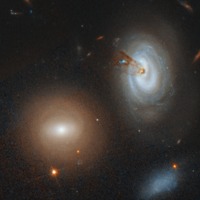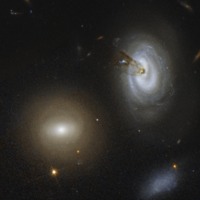Galaxy D100
Dublin Core
Title
Subject
Description
ABOUT THIS IMAGE
The spiral galaxy D100, on the far right of this Hubble Space Telescope image, is being stripped of its gas as it plunges toward the center of the giant Coma galaxy cluster.
The dark brown streaks near D100's central region are silhouettes of dust escaping from the galaxy. The dust is part of a long, thin tail, also composed of hydrogen gas, that stretches like taffy from the galaxy's core. Hubble, however, sees only the dust. The telescope's sharp vision also uncovered the blue glow of clumps of young stars in the tail. The brightest clump in the middle of the tail (the blue feature) contains at least 200,000 stars, fueled by the ongoing loss of hydrogen gas from D100.
The gas-loss process occurs when D100, due to the pull of gravity, begins falling toward the dense center of the massive Coma cluster, consisting of thousands of galaxies. During its plunge, D100 plows through intergalactic material like a boat plowing through water. This material pushes gas and dust out of the galaxy. Once D100 loses all of its hydrogen gas, its star-making fuel, it can no longer create new stars. The gas-stripping process in the beleaguered galaxy began roughly 300 million years ago.
The reddish galaxies in the image contain older stars between the ages of 500 million to 13 billion years old. One of those galaxies is D99, just below and to the left of D100. It was stripped of its gas by the same process as the one that is siphoning gas from D100. The blue galaxies contain a mixture of young and old stars. Some of the stars are less than 500 million years old. The Coma cluster is located 330 million light-years from Earth.
The Hubble image is a blend of several exposures taken in visible light between May 10 and July 10, 2016, and November 2017 to January 2018, by the Advanced Camera for Surveys.
ABOUT THE OBJECT
Object Name:
D100
Object Description:
Ram pressure stripped galaxy
Object Position:
R. A. 13:00:09.127
Dec. +27:52:02.998
Constellation:
Coma Berenices
Distance:
330 million light-years
Dimensions:
Main image is 45 arcsec across (about 72,000 light-years); Secondary image is 1.8 arcmin across (about 173,000 light-years)

